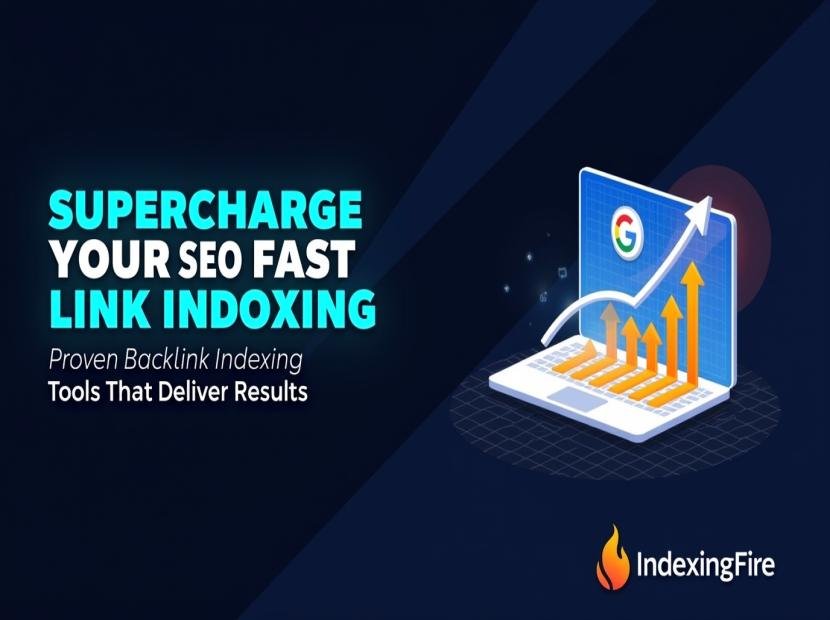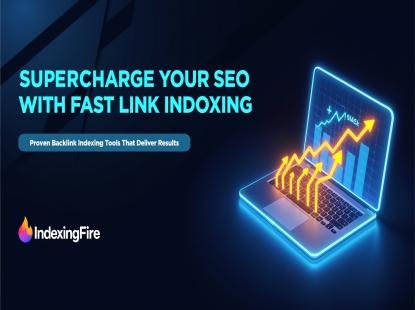
Supercharge Your Rankings with the Ultimate Backlink Indexing Service: A Complete Guide
Introduction
In today’s fast-paced digital landscape, quality backlinks remain one of the most important factors for improving search engine rankings. Yet, even the strongest link won’t register if Google never finds it. This is where a dedicated backlink indexing service becomes indispensable. If you’re still relying on manual pinging or hoping that the search engines crawl your links on their own schedule, you’re missing out on faster results. A professional link indexing service and instant link indexer—especially a reputable backlink indexing tool ensure each link you build gets indexed quickly, sending authority to your website sooner than your competitors. In this comprehensive guide, we’ll explore what makes the best backlink indexing tool, how to integrate a website indexing tool into your workflow, and why prioritizing index speed is crucial for SEO success.
1. Understanding the Role of a Backlink Indexing Service in Modern SEO
A backlink indexing service operates as an accelerator between your newly built links and Google’s index. Here’s why it matters:
-
Bridge to Search Engines
Normally, Google’s crawlers discover links through organic site activity—reading sitemaps, following internal links, or stumbling across social posts. A professional link indexer cuts out the guesswork by pushing your URLs to multiple high-authority indexing endpoints. -
Ensuring Link Equity Transfers
An indexed link passes “link juice” to your site, boosting your domain authority and helping individual pages rank. When a backlink remains unindexed, it’s powerless in terms of ranking influence. That’s why every savvy SEO invests in a backlink indexer. -
Competitive Advantage
While your peers wait days or weeks for Google to discover their links, a fast indexing tool lets you leapfrog ahead. The sooner your links appear in the search index, the quicker you can see rank improvements.
2. Key Differences Between Link Indexing and Traditional Crawling
Understanding how link indexing differs from standard crawling helps illustrate its value:
-
Scheduled vs. On-Demand
-
Traditional Crawling: Googlebot visits websites on its own schedule. If your website isn’t crawled frequently, new backlinks might take weeks to appear.
-
Link Indexing Service: An on-demand solution. You submit your links directly, prompting immediate crawling signals. This is especially critical for pages that don’t get frequent traffic or internal updates.
-
-
Selective Submission
-
Crawling: Focuses on pages Google already knows. It might not revisit every page instantly.
-
Indexing: Specifically targets newly published or external backlinks. Services like the best Google indexer actively push URLs to Google’s Indexing API (when eligible), ensuring prompt recognition.
-
-
Fallback Methods
-
While Google’s official Indexing API supports only job listings and video content, a professional backlinks indexer uses multiple channels—RSS feeds, social signals, and sitemap pings—to cover any backlink type. This multi-channel approach accelerates link discovery beyond what Google’s native crawling offers.
-
3. Why You Should Partner with a Backlink Indexing Tool, Not a Freebie Ping Service
Many SEOs attempt free ping or bookmark sites to get links crawled faster. Here’s why a specialized backlink indexing tool is superior:
-
Reliability & Consistency
Free ping services often get blocked, throttle your submissions, or simply fail to register all URLs. A dedicated link indexing service invests in rotating IPs, robust servers, and multiple submission endpoints, ensuring most links are processed consistently. -
Safety & Compliance
Cheap or free tools may use black-hat tactics—scraping low-quality link farms, creating footprints, or bypassing webmaster guidelines. The best backlink indexer adheres to Google’s rules. By using white-hat methods, it minimizes penalty risk, safeguarding your website’s long-term health. -
Comprehensive Reporting
Free methods rarely provide feedback. A professional backlink indexing tool logs every submission and tracks indexing status in real time. You’ll know exactly which backlinks indexed successfully and which need resubmission—no more guesswork. -
Support & Updates
Most free tools offer no support. When you work with a reputable website indexing tool, you gain access to a support team that can troubleshoot submission errors, advise on best practices, and optimize your workflow over time.
4. Identifying the Best Backlink Indexing Tool for Your Needs
Not all best backlink indexing tools are created equal. When selecting one, evaluate these factors:
-
Indexing Success Rate
Look for a provider that advertises an 80–90%+ average indexing rate. Anything below that means you may need to resubmit dozens of URLs, effectively increasing your cost per indexed link. -
Index Speed
The term fast indexing tool is not a gimmick—true leaders index most links within 2–4 hours. Compare providers’ claims and user testimonials to find the instant link indexer that delivers the quickest turnaround. -
Safety Protocols
Confirm that the tool uses white-hat techniques. The best link indexer avoids mass bookmarking sites that have low trust scores or user-generated spam. Instead, look for a service that uses Google’s Indexing API (when allowed) and high-authority RSS feed pings. -
API & Automation
For scaling your SEO efforts, integration is key. The best Google indexer platforms provide a well-documented REST API, allowing you to submit links directly from your internal dashboards or SEO tools. Check for rate limits, daily quotas, and code samples in PHP, Python, or Node.js. -
Reporting & Analytics
A robust backlink indexer provides a dashboard that tracks URL status: pending, indexed, or failed. Look for features like CSV/PDF exports and email/webhook notifications, which streamline campaign management. -
Cost & Volume Discounts
Evaluate pricing structures. Generally, backlink indexing tool providers use a credit-based system—each credit equals one URL submission. The more credits you buy, the lower your per-URL cost. Compare per-URL pricing at various tiers to find the best value.
5. Evaluating the Best Backlink Indexer Features: Reliability, Speed, and Safety
Once you’ve narrowed down a few candidates, dig deeper into feature sets:
-
High Throughput Processing
-
A truly fast indexing tool can handle thousands of URLs per batch without timing out.
-
Check if providers impose per-batch size limits or throttle simultaneous submissions to keep up with demand.
-
-
Multi-Channel Submission Methods
-
The best backlink indexing tool combines Google’s Indexing API, RSS feed pings, sitemap updates, and social signals (e.g., Twitter, LinkedIn posts).
-
This multi-pronged strategy increases the chance of a quick discovery by Googlebot.
-
-
Automated Resubmission Workflow
-
Any reputable backlink indexer should automatically retry failed submissions after a predefined interval (usually 24 hours).
-
If a URL ultimately fails (e.g., due to a 404 error or disallowed robots.txt), it should refund your credit or flag it for review.
-
-
IP Rotation & User Agent Diversity
-
To avoid blocks or throttling, a quality link indexing service rotates IP addresses and user agents.
-
This mimics real user behavior and reduces the risk of Google flagging your traffic as spammy.
-
-
Comprehensive Logging & Error Codes
-
Detailed logs show which URLs returned a 200 OK, which returned a redirect, and which returned a 404 or 500.
-
The best link indexer provides actionable error codes so you can correct underlying issues (e.g., broken links or server misconfigurations) before resubmission.
-
-
User-Friendly Dashboard & API Documentation
-
Look for a simple, intuitive interface that lets you paste in URLs, view status updates, and download reports.
-
For advanced users, check that the API documentation is clear on endpoints, request formats, response structures, rate limits, and error handling.
-
6. How an Instant Link Indexer Transforms Your Link Building Workflow
An instant link indexer changes the game for any SEO professional or agency by:
-
Reducing Manual Overhead
Instead of copy-pasting each URL into various free ping tools, you can submit bulk lists in seconds and let the system handle the rest. -
Eliminating Guesswork
When you rely on organic crawling, you never know when or if a link will get indexed. With professional indexing, you see real-time status updates—no more checking Google Search Console for days on end. -
Enabling Faster Campaign Iterations
Since you know which links indexed successfully within hours, you can pivot your outreach strategy immediately. If certain link types consistently underperform, you stop investing in them and focus on high-quality placements that index quickly. -
Streamlining Client Reporting
Agencies can send clients detailed CSV or PDF reports showing which URLs indexed, which are pending, and reasons for any failures. This transparency fosters trust and demonstrates ROI. -
Scaling with Confidence
When you manage multiple websites or client accounts, integrating a website indexing tool via API automates large-scale submissions. You can schedule nightly batches or trigger instant indexing every time a new backlink is acquired.
7. The Power of a Website Indexing Tool: Integrations and Automation
Modern SEO workflows demand automation. A robust website indexing tool provides:
-
RESTful API for Easy Integration
-
Submit URLs programmatically from your own applications, whether it’s a custom CRM, a white-labeled client portal, or an internal dashboard.
-
Automate link indexing as soon as a new link is recorded—no manual intervention required.
-
-
Webhooks and Notifications
-
Configure webhooks to receive instant alerts when link statuses change (e.g., from “pending” to “indexed”).
-
Use email or Slack notifications to keep your team informed without constantly logging into the dashboard.
-
-
Bulk Upload via CSV
-
If you have thousands of URLs—such as a large guest-post campaign—simply upload a CSV file. The system queues each link and processes them automatically.
-
Some backlink indexing tool providers even offer Google Sheets integration, letting you maintain your link list in a spreadsheet.
-
-
Priority Lane & Custom Scheduling
-
Many services offer a “priority indexing” feature for time-sensitive links (e.g., product launches or seasonal promotions).
-
Schedule batches to run during off-peak hours to align with search engine crawl patterns.
-
-
Usage Analytics & Quotas
-
Monitor daily or monthly submission quotas to avoid API errors.
-
Track how many credits you’ve used, how many remain, and plan top-ups accordingly.
-
8. Step-by-Step: How to Index Backlinks Using a Fast Indexing Tool
Follow this workflow to ensure your backlinks get indexed as quickly as possible:
Step 1: Prepare Your Link List
-
Compile each new backlink into a simple text file or spreadsheet (one URL per line).
-
Double-check that each URL returns a 200 OK status in your browser.
Step 2: Select Your Backlink Indexing Tool
-
Choose a service known for a high indexing rate, robust API, and transparent pricing. Sign up and claim any free trial credits if available.
Step 3: Submit a Small Test Batch
-
Upload or paste 10–20 URLs into the dashboard’s “Index Links” section.
-
Select “Standard Indexing” or “Priority Indexing” based on urgency.
-
Hit “Submit” and wait 2–4 hours to review initial results.
Step 4: Review the Report
-
Navigate to the “Reports” tab.
-
Note which URLs show as “Indexed” versus “Pending” or “Failed.”
-
For any failed URLs, read the error codes (e.g., “Blocked by robots.txt,” “404 Not Found,” or “Duplicate Content”) and correct them on your end.
Step 5: Resubmit as Needed
-
If a URL shows “Pending” after 24 hours, you can manually resubmit or rely on the automated resubmission workflow.
-
Make sure to address any root-cause issues for consistent failures (e.g., server downtime or misconfigured redirects).
Step 6: Scale Up Batch Size
-
Once your test batch yields a high indexing rate (above 80%), upload larger batches—500 to 1,000 URLs at a time.
-
Use volume discounts to lower your per-URL cost if you’re purchasing credits.
Step 7: Integrate Via API (Optional)
-
If you’re an agency or manage multiple domains, set up the provider’s API in your system.
-
Automate real-time submissions every time a new backlink is recorded, ensuring no delay between acquisition and indexing.
9. Measuring Success: Tracking Your Indexed Backlinks Over Time
A backlinks indexer isn’t just about quick results; it’s about sustained growth. Track these KPIs to gauge effectiveness:
-
Indexing Rate
Monitor the ratio of indexed URLs to total submitted. Aim for an 85–90%+ success rate to ensure cost efficiency. If the rate drops below this threshold, revisit your link quality sources. -
Keyword Rank Improvements
Map your newly indexed backlinks to target keywords. Track pre- and post-index rankings using tools like Google Search Console, Ahrefs, or SEMrush. Notice rank jumps as soon as links get indexed. -
Organic Traffic Changes
Compare organic visitor data for pages receiving new backlinks. Increased visibility and traffic indicate the backlinks are passing authority as intended. -
Average Time-to-Index
Record how long it takes for a backlink to move from “Pending” to “Indexed.” If your instant link indexer consistently accomplishes this in under 4 hours, you have a competitive edge. -
Cost per Indexed Link
Calculate total spend versus number of indexed URLs. A lower cost per indexed link indicates you’re using your fast indexing tool efficiently.
10. Common Pitfalls When Choosing a Backlink Indexer (and How to Avoid Them)
Even seasoned SEOs make mistakes when selecting a best backlink indexer. Here are pitfalls to watch for:
-
Focusing on Price, Not Performance
-
Selecting the cheapest per-URL rate often means sacrificing indexing speed or success rates.
-
Always balance cost with ROI—if a slightly more expensive service indexes 90% of your links versus 60%, it’s ultimately more cost-effective.
-
-
Ignoring Service Transparency
-
Some providers advertise “unlimited indexing” but lack clear reporting. Without detailed logs, you’ll have no idea which links actually indexed.
-
Choose a service that openly shares indexing statistics and error codes.
-
-
Overlooking Safety Protocols
-
Black-hat tactics (e.g., scraping low-quality bookmarking sites) might yield short-lived indexing, but they come with high penalty risk.
-
Verify the provider follows Google’s Webmaster Guidelines and uses legitimate channels—especially if they claim to be the best Google indexer.
-
-
Underestimating API Documentation Quality
-
If you plan to integrate the tool into your own systems, skim the API documentation first. Poorly documented endpoints and inconsistent response formats can hinder automation.
-
Look for sample code, clear error handling guidelines, and defined rate limits.
-
-
Neglecting Customer Support
-
When link indexing fails, you need a responsive support team. Free or no-name services often leave users troubleshooting issues alone.
-
Check reviews or forums (e.g., SEO communities) to gauge a provider’s support reputation before committing.
-
Conclusion
Investing in a top-tier backlink indexing service is no longer optional—it’s a must-have in any competitive SEO strategy. While traditional crawling can leave your hard-earned backlinks undiscovered for weeks, a dedicated link indexing service and instant link indexer push your URLs into Google’s index within hours, ensuring every backlink contributes to your authority. By selecting the best backlink indexing tool one that balances speed, reliability, and safety—you’ll see faster ranking improvements, better ROI on your link-building campaigns, and a clear edge over competitors.
Start by testing a handful of URLs with a reputable provider, analyze the indexing rate, and then scale up your submissions. Monitor your indexing success, track keyword rankings, and fine-tune your strategy based on data. If you avoid common pitfalls—like focusing solely on price or ignoring customer support—you’ll be equipped to harness the full power of a fast indexing tool. Ready to take your SEO to the next level? Research your options, claim any free trial credits, and begin submitting your backlinks today. As those URLs quickly move into Google’s index, you’ll watch your organic traffic and search positions climb—proving that when it comes to link indexing, speed and reliability truly matter.



